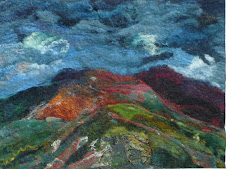

This is just a brief update so that you all know I am still alive. I have been away on holiday to Madeira where apart from chasing up lost luggage I took photos of dragon trees ( on the left ,one species a baby, on the right native dragon trees) and spent the rest of the time lazing by the pool reading-the Kite Runner-amongst others. ( However I also read through Medieval Paints and Inks of which more later)
Since I have got back I have been trying to get my madder dyeing right and thanks to both Dorothy and Leena for supportive comments. I was really starting to tear my hair out when a new delivery of dyes arrived including madder and a new batch has produced a lovely bright orangy red. This has been a very wet autumn and my studio converted from a brick garage is a bit damp and I wonder whether the madder had deteriorated. I am also now dyeing the merino in 100g lots in slow cookers of which I now have four which leaves my five hot rings to mordant and dye my other commission of 600g of welsh wool in 6 different colours for a school project in a nearby town as well as dyeing 400g of merino tops in indigo as a first stage to getting a green with dyers greenweed. I dyed the merino in indigo first and then put it straight into the mordant bath and no surplus indigo was rinsed off -amazing!
I decided to overdye some of my huge amounts of orangy brown merino in indigo to give a lovely warm brown, as brown is something I am usually very short of especially a warm brown, the rest will end up in packs and kits as I have quite a lot of workshops coming up.
The new delivery of dyes included dragons blood . I was expecting a resin but it has come as a bright red powder very like lac. hmm interesting. Well off to start to read 40 Centuries of Ink which also arrived while I was away but not before I am off to see Leighs blog ( see comments) as she has sent me an enticing message!

































